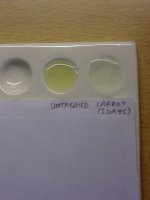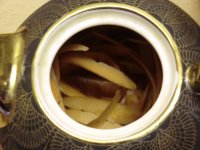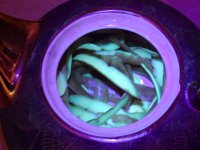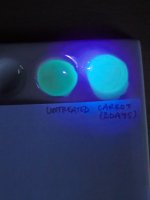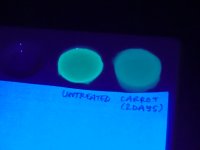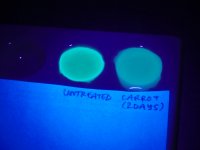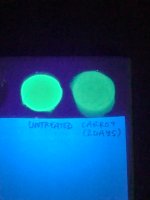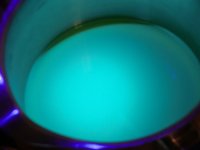So I spent week testing this idea I had since I read about carrots enzymes reducing acetone to secondary alcohol and read up more and saw zinc/magnesium is used to preform the same thing. So in my mind I thought it would work to convert harmaline to THH. On a whim I tossed some carrot shaving into a acidic solution with what I thought was harmaline and left it two days and after removing the carrots and filtering well the color was BLUE and not the green from harmaline.
So then I decided to repeat the experiment with a carrot water to test black light, a magnesium control and a carrot test. No black light shine on carrot water.
I separated the harmine at 7-8 ph and the rest at 12ish. Then proceed to split the harmaline in two equal volumes and started the experiment.
Left everything for two days and before proceeding with filtering and precipitating the colors of the two did match with a blue color.
So to precipitate the thh from magnesium I did masake and got a highlighter yellow powder. and the carrot experiment I just precipitated as normal... it didn't precipitate at 10 but only at 12-13. I thought this was a good sign. I redissolved the hcl in acidic water and precipitated the same way... Also only precipitated at 12-13 range.
The crystals from the magnesium reduction were the nicest I've had yet. (pics)
Now to test I was originally going to do melting point test but since I was working with such small amounts I decided to do black light test after all the filtering. After making an equally acidic solution with citric acid rather than vinegar I placed the filter papers into separate beakers side by side. The magnesium control was a nice blue tone but the carrot was still green. There may have been some conversion however I don't have the ability to test. Visually I'd say it didn't convert however I'm not sure how strong the harmaline color is over THH. Would a 70% conversion of the harmaline still shine green? It wasn't the most noticeable difference but was still greener.
If someone with TLC paper would like to verify or someone with better just explain it doesn't work.
So then I decided to repeat the experiment with a carrot water to test black light, a magnesium control and a carrot test. No black light shine on carrot water.
I separated the harmine at 7-8 ph and the rest at 12ish. Then proceed to split the harmaline in two equal volumes and started the experiment.
Left everything for two days and before proceeding with filtering and precipitating the colors of the two did match with a blue color.
So to precipitate the thh from magnesium I did masake and got a highlighter yellow powder. and the carrot experiment I just precipitated as normal... it didn't precipitate at 10 but only at 12-13. I thought this was a good sign. I redissolved the hcl in acidic water and precipitated the same way... Also only precipitated at 12-13 range.
The crystals from the magnesium reduction were the nicest I've had yet. (pics)
Now to test I was originally going to do melting point test but since I was working with such small amounts I decided to do black light test after all the filtering. After making an equally acidic solution with citric acid rather than vinegar I placed the filter papers into separate beakers side by side. The magnesium control was a nice blue tone but the carrot was still green. There may have been some conversion however I don't have the ability to test. Visually I'd say it didn't convert however I'm not sure how strong the harmaline color is over THH. Would a 70% conversion of the harmaline still shine green? It wasn't the most noticeable difference but was still greener.
If someone with TLC paper would like to verify or someone with better just explain it doesn't work.

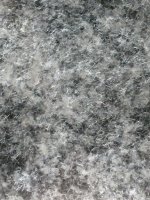
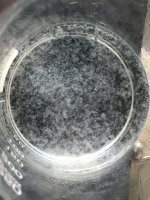
 ) Continuous monitoring would enable pH correction as well as keeping an eye on reaction progress. Maybe an inert atmosphere would help prevent the reverse (oxidation) reaction too?
) Continuous monitoring would enable pH correction as well as keeping an eye on reaction progress. Maybe an inert atmosphere would help prevent the reverse (oxidation) reaction too?